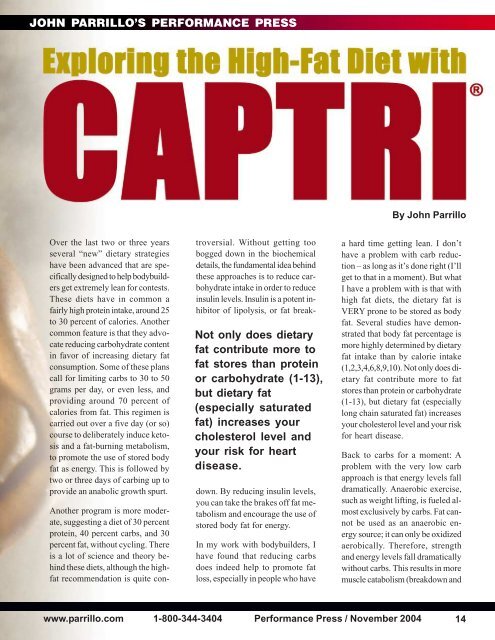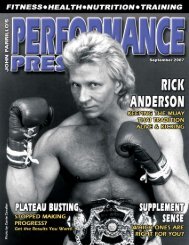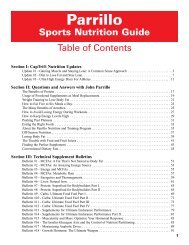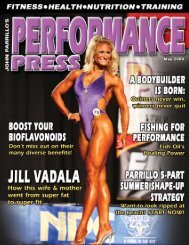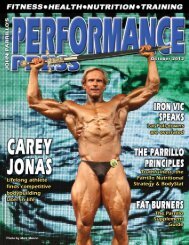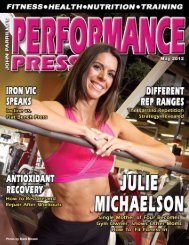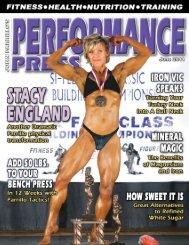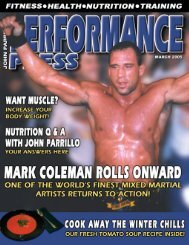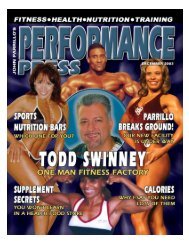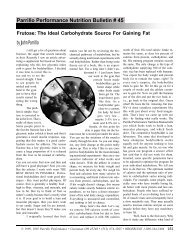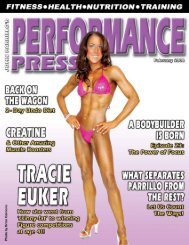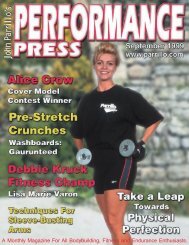November 6-7 - Parrillo Performance
November 6-7 - Parrillo Performance
November 6-7 - Parrillo Performance
Create successful ePaper yourself
Turn your PDF publications into a flip-book with our unique Google optimized e-Paper software.
JOHN PARRILLO’S PERFORMANCE PRESS<br />
By John <strong>Parrillo</strong><br />
Over the last two or three years<br />
several “new” dietary strategies<br />
have been advanced that are specifically<br />
designed to help bodybuilders<br />
get extremely lean for contests.<br />
These diets have in common a<br />
fairly high protein intake, around 25<br />
to 30 percent of calories. Another<br />
common feature is that they advocate<br />
reducing carbohydrate content<br />
in favor of increasing dietary fat<br />
consumption. Some of these plans<br />
call for limiting carbs to 30 to 50<br />
grams per day, or even less, and<br />
providing around 70 percent of<br />
calories from fat. This regimen is<br />
carried out over a five day (or so)<br />
course to deliberately induce ketosis<br />
and a fat-burning metabolism,<br />
to promote the use of stored body<br />
fat as energy. This is followed by<br />
two or three days of carbing up to<br />
provide an anabolic growth spurt.<br />
Not only does dietary<br />
fat contribute more to<br />
fat stores than protein<br />
or carbohydrate (1-13),<br />
but dietary fat<br />
(especially saturated<br />
fat) increases your<br />
cholesterol level and<br />
your risk for heart<br />
disease.<br />
Another program is more moderate,<br />
suggesting a diet of 30 percent<br />
protein, 40 percent carbs, and 30<br />
percent fat, without cycling. There<br />
is a lot of science and theory behind<br />
these diets, although the highfat<br />
recommendation is quite controversial.<br />
Without getting too<br />
bogged down in the biochemical<br />
details, the fundamental idea behind<br />
these approaches is to reduce carbohydrate<br />
intake in order to reduce<br />
insulin levels. Insulin is a potent inhibitor<br />
of lipolysis, or fat breakdown.<br />
By reducing insulin levels,<br />
you can take the brakes off fat metabolism<br />
and encourage the use of<br />
stored body fat for energy.<br />
In my work with bodybuilders, I<br />
have found that reducing carbs<br />
does indeed help to promote fat<br />
loss, especially in people who have<br />
a hard time getting lean. I don’t<br />
have a problem with carb reduction<br />
– as long as it’s done right (I’ll<br />
get to that in a moment). But what<br />
I have a problem with is that with<br />
high fat diets, the dietary fat is<br />
VERY prone to be stored as body<br />
fat. Several studies have demonstrated<br />
that body fat percentage is<br />
more highly determined by dietary<br />
fat intake than by calorie intake<br />
(1,2,3,4,6,8,9,10). Not only does dietary<br />
fat contribute more to fat<br />
stores than protein or carbohydrate<br />
(1-13), but dietary fat (especially<br />
long chain saturated fat) increases<br />
your cholesterol level and your risk<br />
for heart disease.<br />
Back to carbs for a moment: A<br />
problem with the very low carb<br />
approach is that energy levels fall<br />
dramatically. Anaerobic exercise,<br />
such as weight lifting, is fueled almost<br />
exclusively by carbs. Fat cannot<br />
be used as an anaerobic energy<br />
source; it can only be oxidized<br />
aerobically. Therefore, strength<br />
and energy levels fall dramatically<br />
without carbs. This results in more<br />
muscle catabolism (breakdown and<br />
www.parrillo.com 1-800-344-3404 <strong>Performance</strong> Press / <strong>November</strong> 2004<br />
14


